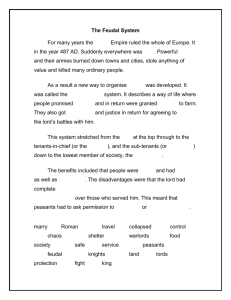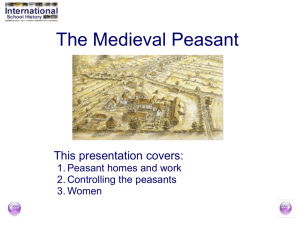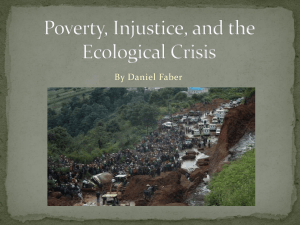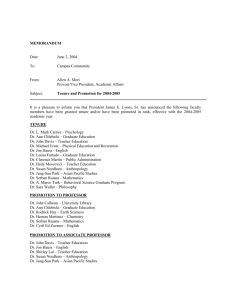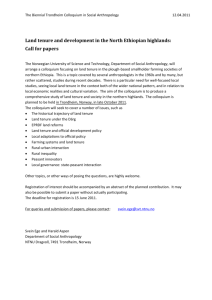LECTURE : INTRODUCTION: ANTHROPOLOGICAL
advertisement
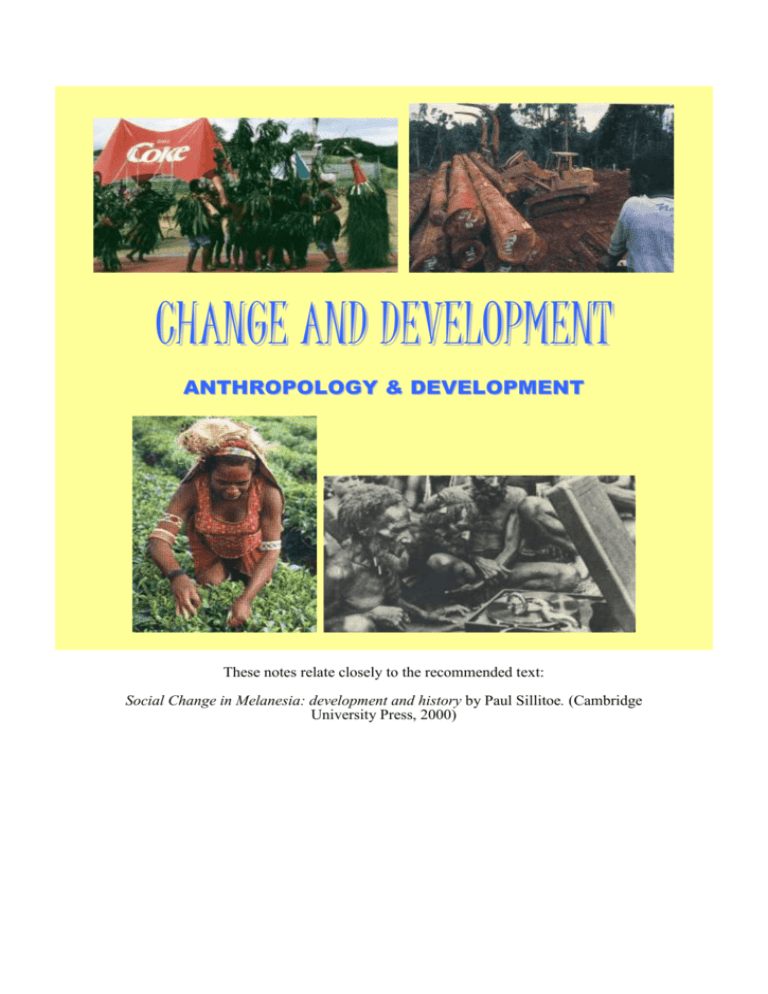
CHANGE AND DEVELOPMENT ANTHROPOLOGY & DEVELOPMENT These notes relate closely to the recommended text: Social Change in Melanesia: development and history by Paul Sillitoe. (Cambridge University Press, 2000) SECTIONS. (click on to return to this page) I. Introduction: anthropological perspectives on change and development. II. Issues, terms of debate & anthropology's contribution to change and development. III. Technology, innovation, development & change. IV Theories of change and development: modernisation and dependency V. Land, change & economic development VI. Theories of change & development: the entrepreneurial model VII. Rural regions: the peasant condition VIII. International, national & local levels: multinationals, governments & communities IX. The urban areas: migration & urbanisation X. Indigenous responses to change and development I. INTRODUCTION: ANTHROPOLOGICAL PERSPECTIVES ON CHANGE AND DEVELOPMENT. An introduction to social change & economic development : various relevant distinctions and the issue of poverty. 1. Light- & dark-skinned brothers myth - we shall concern ourselves with the return of the former's descendants (Europeans) = social change in the Pacific (oral history). 2. EXTERNAL/INTERNAL CHANGE: All societies dynamic & changing - source, extent & speed of change critical factors. Internally generated change - gradual (unless revolution) = evolution. External induced change, but is gradual = diffusion. Fast & chaotic change caused by invading outside forces = today's economic development (modernisation/ dependency). 3. THREE ASPECTS OF CHANGE a. technological innovations b. social consequences c. indigenous rationalisations Technological innovation = when technically superior procedure introduced into tribal/peasant society (usually today through the intrusion of the industrial world). Social consequences flow from technical changes & also socio-cultural modifications forced on traditional society by outside powers; relations with outside authorities. Indigenous rationalisations = people trying to make sense of changes in terms of what they know, and to manipulate them (not daft!). 4. POVERTY: Poverty = chronic problem of lesser developed countries. Eradication of poverty = major reason given for promoting economic development & associated social change 5. CAUSES OF POVERTY: a. lack of modern technology b. lack of 'modernising outlook' c. physical & environmental limitations. d. governmental & administrative obstructions e. dependency relations between First & Third Worlds f. local socio-economic relations of exploitation Vicious cycles of poverty: the difficulty of breaking them II. ISSUES, TERMS OF DEBATE & ANTHROPOLOGY'S CONTRIBUTION TO CHANGE AND DEVELOPMENT. 1. SOME TERMS DEFINED: Economic development = more properly technological development -usually reckoned beneficial (poverty alleviation). Social change = changes in social order - cannot be judged as good or bad (culturally relative issues). Applied anthropology = how can we apply anthropology? What anthropology has to contribute to development/change issues. Only advise on social consequences. Third World = world's less technologically developed nations, though not easy to define. North-south debate = division of world into developed & undeveloped, but woolly. Colonialism & neo-colonialism = industrial political suzerainty over colonies, transformed later to insidious economic control (via multi-nationals etc.) 2. TWO LEVELS OF DEVELOPMENT: Nationally planned macro-level development - concern of economists & politicians. Grass-roots micro-level development – where anthropologists' interests centre. 3. PARTICIPATORY DEVELOPMENT: a. Relatively new viewpoint - people, not capital, centred b. A direct role for anthropology. Primacy given to indigenous knowledge (IK). c. Approaches to participation: i. local people contribute to programmes ii local people organise themselves iii empowering local populations 4. PROBLEMS WITH PARTICIPATION: a. Political obstacles b. Administrative obstacles c. Social obstacles d. Project obstacles 5. BENEFITS OF PARTICIPATION: a. More efficient, cost-effective projects b. More effective use of resources (esp. local) c. Promotes self-reliance, breaks dependency relations d. More sustainable development III. TECHNOLOGY, INNOVATION, DEVELOPMENT & CHANGE. The role of technology, and technological innovation, in socio-economic change: causes and effects. 1. TECHNOLOGICAL CHANGE Factor Substitution: change in inputs, output constant Technical Change: resources same, output increased 'Neutral' Technical Change: ration of inputs remains the same (at given factor prices) 'Biased' Technical Change: favours using more of one productive resource than another (maybe capital-saving, labour-saving or neutral) 2. INDUCED INNOVATION When certain resources become scarce, their scarcity induces the search for technical innovations to overcome their relative shortage of supply. Criticism = assumes perfect competitive market, which not so for poor Third World farmers 3. LABOUR-SAVING INNOVATIONS a. From stone to steel axes: 1. Indirect change, before Europeans actually arrive : instructive because relatively few forces at work. Cannot observe directly - conditions reliability of studies. 2. The Siane, typical New Guinea highlanders (see R. Salisbury From stone to steel); discovered 1933, by 1950s administrative control established and directly induced change taking place 3. Most profound indirect change = arrival of steel axes, exchanged over large distances. According to Salisbury steel 3 or 4 times quicker, reducing time Siane men engaged in subsistence work from 80% to 50% of their lives. Wola research suggests wildly askew - steel only 1.4 times faster. But this statistic not much use because of problem of comparison. Not only steel tools would have saved time, but arrival of new crops too and other manufactured items (like cloth). b. From axe to plough: 1. The Lala of Zambia (see N. Long 1968 Social change and the individual): introduction of ox-plough and tobacco cash crop (previously swidden farmers) 2. Resulted in: changes in labour organisation, land tenure, village fragmentation, dissolution of matrilineal groups c. From ox-plough to tractor: 1. The introduction of tractors to farmers in Asia (see H.P. Binswanger 1984 Agricultural mechanisation) Economic factors favourable (government distorted) 2. Substitution versus net contribution views: either tractors increase farm size & reduce employment (bad), or increase net output by increasing cultivation efficiency (good) 4. LAND-AUGMENTING INNOVATIONS a. The Green Revolution (modern crop varieties - HYVs) 1. Modern varieties involve net technical change, have substantially increased yields. They require complementary inputs (fertiliser, water etc.). Although scale neutral (inputs infinitely divisible), poor peasants adopt at slower rate. 2. Reliance on purchased inputs locks peasants into unpredictable market = risk (also yields more variable) 3. Problems observed, more to do with imperfect factor markets than the technology (v. impressive plant breeding) 5. TRIBAL RESPONSE TO TECHNOLOGICAL CHANGE Steel-changed behaviour: How did Siane use time saved? They did not increase subsistence production, being content with their lot According to Salisbury by fighting more wars & increasing ceremonial exchange activity. Warfare argument unconvincing. European import of shell wealth very important regarding ceremonial exchange inflorescence. Salisbury speculates that women flowed against wealth towards those living around European centres. See no reason why number of exchanges should have increased, as opposed to inflation in their size. Furthermore Salisbury maintains that stimulus to ceremonial exchange resulted in increased pig production, which is where men may have used time saved (to produce more wealth). IV THEORIES OF CHANGE AND DEVELOPMENT: MODERNISATION AND DEPENDENCY Socio-economic changes in production proceed as series of discontinuous jumps as capital investments/technological developments made, but overall trend is increasing material prosperity = growth and modernization 1. STEP-DEMAND CHANGES Regardless of criticisms, significant point is that Siane did not increase production Instead they increased ceremonial exchange related activities - great social pressure to do so. Left alone, no reason why Siane should break out of this madly inflating situation - but industrial world inevitably breaks in. In paying Siane, Salisbury noticed shift in preferences from wealth to consumable luxuries to manufactured consumables to cash - his explanation unsatisfactory, but he noticed changes occurred as jumps. 2. JUMPING DEVELOPMENT Economist's abstract model linking tribal subsistence economy to monetary one. Assumes that subsistence economies have concealed surplus. Developers considers ways of encouraging people to exploit potential surplus. Aim to stimulate take-off (Rostow) and growth. Distinguish between incentive & response factors: Incentive = effort needed to earn cash & opportunity to spend it. Response = traditional attitudes influencing reactions, & manner in which introduced by outside agencies. Development economists concentrate on incentive factor. Returns initially so low & effort so great that people reluctant to increase production - need capital investment to make more profitable to stimulate it, problem is : who will finance such developments initially when no profit to be made given low output in any region? Either profit opportunities expand locally to make it viable eventually. Or, more likely, governments will finance. Similarly regarding incentives to earn money to spend it - where few retail outlets incentive to earn low but who will establish low turnover store hoping to stimulate production & become profitable? Such capital investments cause jumps in output. To break through stagnation points developers urge substantial investment in region by advanced economy - either private or government. 3. THEORIES OF MODERNIZATION Neo-evolutionary - assumes linear transformation of 'traditional' societies to 'advanced' (i.e. Western) ones The 'structural differentiation' model (after Smelser) = process whereby more specialised and autonomous social units develop (i.e. development = more differentiated structure & its integration) Development occurs by: a. modernization of technology b. commercialization of agriculture c. industrialisation d. urbanisation Essentially ethnocentric (i.e. development = what happened in Western capitalistic nations). We have to set assumptions within other unique cultural and historical contexts 4. DUALISTIC THEORIES Traditional-modern dichotomy represented as rural (or folk)-urban duality (originates in anthropology with Redfield's continuum) Dualistic theories of development postulate two different sectors in LDCs: the modern, capitalist, industrial sector and the traditional, non-profit, largely subsistence agricultural sector 5.THEORIES OF DEPENDENCY Associated with Marxist thinking and sets LDCs within wider socio-historical context, arguing that lesser developed nations are dominated economically & politically by, and dependent upon, outside industrial powers (= neo-colonialism) The metropolitan-satellite relationship (after Frank) - the former expropriates economic surplus of latter - marked by sharp class structure (both external & internal to any nation) Criticisms = i. assumes (like modernism) that traditional forms of organisation are eliminated by 'intrusion of capitalism', which untrue. ii. overlooks co-operation within and between opposing interest groups (classes), overlapping interests. iii. metropolitan-satellite relations not arranged in simple hierarchy iv. satellites may manipulate resource allocation too, to some extent. The modes of production approach considers multi-structural nature of LDC economies through the analysis of production systems. Seeks to explain why traditional arrangements of production persist with intrusion of commodity markets, the articulation of different productive systems 6. NORMATIVE APPROACHES A concern with how development should proceed, rather than theories about how it has occurred (i.e. practioners versus academics) Some of the issues: a. a concern with global interdependence b. the basic needs approach - concentrating on poverty c. eco-development - concerns with environmental issues and sustainability d. transformation of power relations (the haves giving to the have nots) e. autonomy and interdependence - participatory development f. the ignored, largely women (WID) g. people first, not capital V. LAND, CHANGE & ECONOMIC DEVELOPMENT The ways in which traditional land tenure conflict with objectives of economic development, & how the latter might be modified to accommodate the former rather than obliterate it (& the societies concerned). Abstract economic plans and social theories all very well but 'response factors' also vital peoples' responses to development particularly heated regarding land. 1. LAND ALIENATION Land alienation obvious source of tension. In early colonial days large-scale annexation for expatriate planters but national governments alienating land today face same problems Areas alienated in the Pacific vary – New Caledonia = 80.5%, Fiji = 17.6%, PNG = 4.8% But figures based on total land area - large regions physically beyond development. Annex best land and leave natives with poorer less developable areas. One region badly affected = Gazelle Peninsula region of Tolai people (see A.L. Epstein 1969 Matupit) 2. TRIBAL LAND TENURE Traditionally tribal people cannot sell land, that is cannot alienate it - therefore when accepted goods from Europeans for them to use it, they did not think they were handing over title in perpetuity - this argument forms basis of many indigenous land claims Rights to land depend on kin connections to land holding corporations - e.g. with Tolai = matrilineal vunatarai group; system very flexible (as throughout the Pacific) - a wide range of varyingly connected people claiming land on any territory. Fundamental point is that all tribal people traditionally have access to all the land they need. 3. TENURE AND DEVELOPMENT Developers maintain that traditional tenure hinders development. They maintain that individual freehold tenure essential to encourage people to invest in land - an erroneous ethnocentric judgement. Also need individual freehold so land can serve as collateral to raise loans for development - but financial institutions could change conditions. Also traditional tenure results in small fragmented holdings that militate against economy-of-scale developments - but no individual farming household could finance these anyway. The perennial cash crops now cultivated on considerable scale (for market sale) are introducing undesirable rigidity into traditional tenure where flexibility an essential feature = detrimental change. Cash crops also take land away from subsistence crops & threaten nutritional & health problems. 4. LAND & SOCIETY Changes to land holding arrangements certain to have social consequences. Land Tenure Conversion Ordinances & nucleus estate settlement schemes = two strategies to undermine traditional tenure. Land not merely an economic asset, is fundamental to tribal social organisation - e.g. Tolai where it maintains people's cultural identity. To try and change traditional land tenure is to assault entire culture - no wonder people resist it? 5. SHARECROPPING TENANCY Peasant tenure where rent = percentage of crop yield. Involves contractural arrangements between landowners and tenants The pesistence of these tenancy arrangements a socio-economic puzzle, the answer to which relates to inter-locked factor markets The tenant viewpoint = labour use sub-optimal & sharecropping inefficient (at landowner's expense) The landowner viewpoint = landowner sets labour input (subject to market wage rates) & sharecropping efficient - but assumptions doubtful Both models unsatisfactory - notion of risk-aversion helps solve puzzle (uncertainty due to imperfect labour markets, crdit difficulties, management problems Interlocked factor markets = range of transactions covered by sharecropping contract (e.g. labour services, loans, cost sharing etc.) Neo-classical economic viewpoint = allows profit maximising landlord to overcome inefficiencies of fragmented markets Marxist viewpoint = ensures exploitation of poor tenant family 'semi-feudalism' 6. LAND REFORM Drastic re-organisation of land holding arrangements intended to free peasants from dependence on landlords Many problems attend land reform - e.g. land areas involved, compensation arrangements, evasion etc. It has only really been effective where bloody revolution has occurred - can socioeconomic equalities ever be controlled? VI. THEORIES OF CHANGE & DEVELOPMENT: THE ENTREPRENEURIAL MODEL The role of local entrepreneurs in promoting change and the limiting conditions imposed on their endeavours by their culture's structure values and so on. 1. ENTREPRENEURS An economic concept = risk-taking innovators/brokers Socio-economic studies focus on two themes: i. socio-cultural values that promote entrepreneurial behaviour (after Weber) ii. individual factors that promote the rise of entrepreneurs, what in their social background encourages their emergence? Two broad approaches to these issues: i. the transactional approach ii. the decision-making approach Some motivating factors: a. religious beliefs (e.g. the Protestant work ethic) b. marginal social status (e.g. lack of esteem) Some problems faced by would-be entrepreneurs: a. insufficient familiarity with modern business organisation b. reluctance/inability to delegate responsibility c. estrangement from kin and cultural roots Small-scale entrepreneurial activity of the kind that typifies LDCs is important aspect of the 'informal sector', now recognised as important issue in urban contexts 2. ENTREPRENEURS IN THE PACIFIC 1. Not all traditional aspects of Melanesian society impede development, some - like the achieved leadership system - promote it. 2. Big men as entrepreneurs (see B. Finney 1973 Big-men and business). Goroka region: region suited to coffee, crop on which rapid development depended (easy to grow, demanded very high price, & individuals can grow it). European settlers supplied required capital & assistance In short, incentive factors very good. 3. BIG-MEN TO BUSINESSMEN Some internal response factors favourable too - big man role significant Traditional big man role = status achieved by those who excel in certain fields. But today's business leaders not necessarily yesterday's big-men - more than motivation & opportunity to achieve significant. The chance historical encounters today's business leaders had with Europeans very important. Also, in saving earnings they acted aberrantly, not like big-men. Today's businessmen acted like disenchanted innovators described elsewhere. 4. INDIVIDUALITY OF INNOVATORS Through individual efforts that men succeed, not relying on kin-group. Enterprises centre on individual business big-men. The place of individual action in traditional society very important for promoting developments (incorrect to suggest social groups co-operate, rallying behind big-men). What big-men do is mobilise investment potential of several people - each helping as an individual & expecting individual reward - i e based on reciprocity 5. EXCHANGE INVESTMENT The ability of businessmen to raise capital from relatives very important. When confident in their abilities, relatives invest in their enterprises, in anticipation of individual return payment Exchange ethos initially promotes development (encouraging development) and later hinders it (demanding repayment) - e.g. returning indentured labourers Successful ventures are those not depending heavily on kin contributions. 6. FLAGGING DEVELOPMENT Businesses grow so far and then stop One reason centres on nature of status in an egalitarian society - if too successful offend egalitarian ethic & fear violent reprisals. Another reason is Highlanders have very limited demand for manufactured items & need of cash. Other demand for cash is as wealth to give in ceremonial exchange - initially great, but soon fell off because of inflation & subversion of exchange system by working for, not transacting for, wealth. Traditional Highland society initially promotes favourable response to commercial growth & later an unfavourable one, causing developments to flag. Outside factors have also been significant, contributing to flagging of development : fall in coffee prices, independence & expatriates leaving. Change was too swift - need steady change built on education to have lasting effect. While entrepreneurs significant in promoting change & growth, they can only achieve limited amount if society does not change with them. VII. RURAL REGIONS: THE PEASANT CONDITION The transition from tribesmen to peasants with the intrusion of industrial powers; the implications of this change in status, and its socio-economic consequences. 1. TRIBESMEN CONTRASTED WITH PEASANTS Tribesmen = Small-scale, kin-ordered, self-sufficient social orders. Peasants = communities encapsulated within larger economic & political order - produce own subsistence & surplus for sale. 2. PEASANT SOCIETY Characteristics of peasant society: a. communities in transition b. engage in market, part of larger economic system c. relations of subordination; exploited (by both external & internal agents) Peasant household = unit of production & consumption: a. have access to land (land tenure arrangements) b. family supplies labour c. no profit motive prominently evident d. part of output used for subsistence e. only partially integrated into markets f. reciprocal transactions prominent g. face imperfect markets (e.g. credit problems, input supply irregular, market information & communications poor etc.) 3. PEASANTS DEFINED Peasants live in family farm household units, having access to land, using family labour largely in production; they are always situated peripherally in a larger socio-economic system, being engaged partially in markets which function with a marked degree of imperfection. 4. SUBSISTENCE DEVELOPMENT The urge of peasants to maintain subsistence self-sufficiency indicates need for development of traditional agriculture. Peasants hang on to subsistence self-sufficiency vital that not jeopardised before stable economic alternative established. Not evidence that peasants fatalistic - is sensible insurance in unpredictable world Suggests that peasant status is terminal phase? As inevitable dependence on traditional subsistence regime, need to develop its potential to give growth firm basis Various ways of improving swidden systems: 1. new crops; 2. technology improved; 3. fallow cover improved; 4. shifting pattern rationalised; 5. combining subsistence & cash crops. 5. PEASANT SOCIO- POLITICAL STATUS Persistence of peasant lifestyle, two opposed views: a. social differentiation inevitable under capitalist pressure (= Marxist position) b. peasant life capable of indefinite existence (due to reciprocal norms, demography, control over means of production [land, family labour], flexibility etc.) 6. PEASANT EXPLOITATION Surplus appropriation by wider system (by various rent arrangements, price fixing, usury, taxation etc.) The state: frequently controlled by small interest groups, using state apparatus to keep peasants in place Some commentators maintain that Pacific islanders changing from egalitarian tribesmen to exploited peasants, with a trend, as peasant lifestyle emerges, for a classlike hierarchical structure to evolve. With cash crops have new order arriving simultaneous evolution of a hierarchy. Business big-men become rich peasants = revolution of traditional order But for class structure need evolution of hierarchy principle. 7. CLASSES SUBVERTED Customary land tenure preventing landlessness & emergence of landlord class. Commercial ventures centring on one man collapse with his death, preventing empire building (also means ventures unlikely to grow to enjoy benefits of scale). Demands of ceremonial exchange also tend towards equality - for to achieve renown men still have to excel in this field (so dispersing ambitious entrepreneur's profits). Warfare subverts class development - if too successful men fear revenge and in periodic wars; big-men lose their capital. 8. CLASSES PROMOTED It is on national not local rural level that we find pressures towards evolution of classes The colonial era has left central governments. The business big-men invariably run for political office, whence they can co-ordinate attack on those features of traditional society preventing the consolidation of their commercial ventures & emergence of a class structure. Central governments legislate against customary land tenure, encourage companies, no single businessmen, stamp on tribal warfare, and erode away the ceremonial exchange system. VIII. INTERNATIONAL, NATIONAL & LOCAL LEVELS: MULTINATIONALS, GOVERNMENTS & COMMUNITIES The centre versus the periphery - mineral mining (from gold to copper) taken to illustrate the dilemmas of development as seen from the central government's perspective. Centrally planned & directed projects involving multinational companies, control passes outside country. 1. EARLY DEVELOPMENTS: GOLD PROSPECTING Large-scale developments in the Pacific previously centred on plantations, now on mining of minerals. Initially interest in minerals centred on gold - treatment of Pacific Islanders (local pops. & labourers) very bad. Prospectors hardly promoted development, but were responsible for initiating social change, especially in uncontacted regions. Bulolo Dredging Company in 1930s - precursor of mining developments to come. 2. NATIONAL INCOMES: On occasion gold was a significant export from the Pacific, foreshadowing later situation with minerals. Copper & nickel now major minerals - make significant proportion of earnings of PNG, West Irian & New Caledonia. Governments keen to promote mineral extraction to reduce reliance on aid - but remain dependent on industrial finance & technology from overseas. Governments & companies aim to make profit - local people feature insignificantly in plans. 3. BENEFITS & COSTS BENEFITS = Greatly increased services in region of mine. Increased incomes, from both compensation & opportunity to earn wage. Education & technical training opportunities. Multiplier effect - stimulating local production of food etc to sell. COSTS = The loss & destruction of their land, which no compensation can make good. Social adjustment problems - influx of strangers preying on local women, drinking etc. Breakdown in law & order, racial & tribal strife. 4. WHO IS RESPONSIBLE? Some maintain minerals should be left in ground until indigenous people can mine themselves - but many years before they could, & in meantime where is money for development to come from? Double-bind of development - new nations have to co-operate in project severely disruptive to citizens - cannot opt out of modern world. Some argue local people should decide - but they are unaware of consequences & cannot reach informed decisions, to do so need several years of education, which demands time that is not available. If fate of local population ignored will ferment discontent & trouble disruptive to project. Cannot transform traditional culture in a generation - if change too fast anomie & apathy result. We cannot stop 'progress' as anthropologists, only ameliorate its worst effects IX. THE URBAN AREAS: MIGRATION & URBANISATION The migration of people to seek work elsewhere (on indentured labour contracts etc.), and drift to urban areas, which is proceeding at an alarming rate & threatening social disorder. 1. MIGRATION Previously encouraged, now seen as problem Reasons for migration: a. social factors b. physical factors c. demographic situation d. cultural considerations e. communication improvements Characteristics of migrants (personal background, education etc.) Policy implications - rural versus urban development International migration and refugees 2. MIGRANT LABOUR IN THE PACIFIC Those who go elsewhere to work, usually briefly, although some become permanent wage labourers - maintain home ties. In some regards blackbirding a precursor, especially given dubious recruiting practices well into this century. But employers realise that bad recruitment & management will ruin labour supply although their conditions still spartan & hard. Governments also intervened to protect both labourers' & employers' interests - with institution of indentured contracts. Still problem of inducing labourers to work & co-operate - some try paternalism, others intimidation. 3. MIGRATION & SOCIAL CHANGE Governments also intervened to protect rural subsistence base - if too many men left could collapse. Migration of labour disrupts social organisation - especially of families Also experiences of young migrants lead them to question traditional authority & custom - a potent source of social change (e.g. refuse initiations). 4. URBANISATION A major problem in many LDCs Shanties & slums: places of hope or despair? - the evolution of communities - danger of inappropriate ethnocentric standards The informal sector - the dual economy concept - small-scale production and services precarious conditions - transitional phase? 5. TRIBESMEN AS TOWNSMEN Some migrant labourers become long-term urban residents - but majority maintain rural connections, intending to return home (ensures economic security, if out of work). Rural focus extends into towns - those from same culture reside & interact together. Gives rise to ethnic enclaves - tribalism = wantok system in the Pacific. Wantok system perhaps inevitable, but militates against stable urban environment. Results in many isolated ethnic groups within which people are safe, but relations between which are potentially hostile Wantok system also promotes nepotism in employment - workers happiest when they are all of the same cultural background. 6. TRIBALISM VERSUS CLASS Wantok obligations also prevent individuals amassing large savings - have to share (is form of insurance against unemployment). What inter-ethnic interaction there is, taking place on nascent class lines (particularly concerns elite). But demands of wantok system prevent efflorescence into class system - effecting somewhat equal distribution of wealth (to opt out, someone would have to sever links with home). It is between groups that have class-like formations - because of uneven regional development, some cultural groups are better off than others. Needs urgent attention because breeds hostility - tribal fighting common. 7. FROM FOREST TO URBAN JUNGLES Violence unavoidable with clash of cultures - and revenge ethic exacerbates. The alienated atmosphere of urban centres also partly attributable to colonial history, when indigenes were banned. Pacific urban centres, in reverse to European ones, have grown up without industry which they are desperately seeking, to maintain their growth. They are rapidly expanding, with no work for the ever increasing population - combined with wantok insularism results in very volatile social situation. Governments need to arrest urban flow - to promote rural development. X. INDIGENOUS RESPONSES TO CHANGE AND DEVELOPMENT Millenarian movements one response to change. The reactions of Pacific Islanders to social change & development as exemplified by cargo cults - illustrated by the John Frum movement of Tanna. Letter from John Frum - to convey Melanesians' confusion, and to contextualise their response to change. 1. MILLENARIAN MOVEMENTS - THE CARGO CULT Definition = short-lived & frenetic (often repeating) millenarian movements - the millennium notion. Feature prophets who predict cataclysm. Not merely wish for material goods, but express dissatisfaction with relations with Europeans, whose abilities they cannot comprehend - protest against inferior status. Cults = search for ritual formula to rectify situation & secure people rightful share of wealth & power. 2. THE JOHN FRUM CULT Occurred on Tanna, from ~1940 (intermittently) to present. Islanders boycotted missions etc. - incited by mysterious John Frum figure, who said to appear at night to predict cataclysm, & encouraged return to traditional customs- casting away money, & wild feasts. Administration imprisoned supposed leaders, but cult flourished other John Frums, his sons and his prophets appeared (airstrips cleared etc.). When U.S.A. entered during Pacific war & recruited islanders, they were very generous & rich in cargo - resulted in cult developing fixation on U.S.A. U.S. identification persists today - mock parades, red crosses etc. 3. STRESS EXPLANATIONS Commentators have put forward a variety of explanations. Early reports interpreted as responses to intolerable stress = collective madness. Some have interpreted mass hysteria positively, as promoting rapid adjustment to change. 4. MATERIAL EXPLANATIONS Others have concentrated on material emphasis of cults. When Pacific islanders become aware of their material poverty breeds envy, which, unable to rectify, prompts escape in cult fantasies. 5. CONSERVATIVE EXPLANATIONS Reverse of above - argue that cults a rejection of European ways = nativism. Crude version = cults filled void left by missions forbidding customary practices. Another version centres on exchange = cults to accommodate inflation in wealth. Whatever role of conservation, cults have roots in traditional culture (e.g. myths used to justify cult behaviour) people predictably try to explain what they cannot understand in familiar terms. From this perspective can see cults not irrational. 6. STATUS EXPLANATIONS Pacific islanders expressing discontent with newly imposed order & their lack of status - they abhor European/elite dominance & racism. In cults islanders wish to oblige Europeans/elite to treat them as equals & share (find here exchange emphasis). Cults = protest over deprivation of status - wish to instate big-man model of behaviour. Big-men also important in generating cults, as leaders. 7. NATIONALISTIC EXPLANATIONS Marxists argue cults are nascent nationalistic movements, wish to cast off colonialism/neo-colonial legacy. Promote this by bringing together stateless groups into one protesting group, and articulating their feelings of frustration with their situation. However you interpret cults, they undoubtedly play important role in allowing people to cope with massive change.

